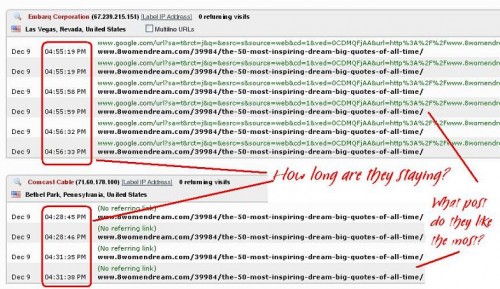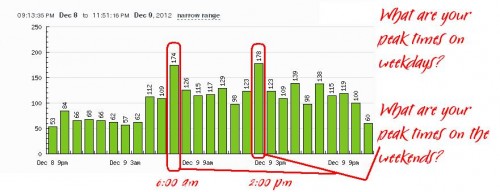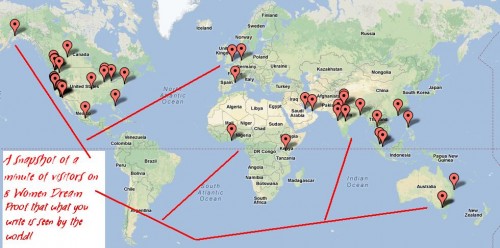My son has officially decided that he hates his statistics class. He loves math; hates statistics. I don’t think that he is alone in that sentiment. Statistics are defined in the dictionary as the science that deals with the collection, classification, analysis, and interpretation of numerical facts or data, and that, by use of mathematical theories of probability, imposes order and regularity on aggregates of more or less disparate elements.
Have you already fallen asleep?
If you want to have a top blog, you have to look at your statistics and you just can’t look at the numbers and be happy with the results. You have to dig deeper and actually look at what your visitors are doing on your blog and why they are doing it. It’s kind of like trying to figure out what a baby wants when it’s crying.
You have to care enough to see if what you are writing matters to anyone. And you have to care enough to fix where your blog is falling short.
If you don’t do this, you will never be a successful top blogger.
First you will need to install Google Analytics or StatCounter or any one of the web statistic collectors on your site and at least once a month you need to pour through the data and find out the following blog statistics:
1. What post do visitors seem to like the most and how long do they stay?
Having a post that gets a lot of traffic doesn’t necessarily mean that visitors actually like the post. If you dig down into your stats and look at how long your visitors are staying on a post and how high the bounce rate is you will learn if you are smelling roses where there is a poopy diaper. You could have a blog post that gets 500 visits a day, but if your visitors only stay for 10 seconds or less (or not long enough to read the post) or it has a high bounce rate too, then there is something seriously wrong with the post and you need to fix it.
2. Is there a post people stay a long time on, but it’s not in your top 30 posts?
Sometimes you have a great post that visitors are accidentally finding and enjoying reading, but something in your title, your keywords or your meta description isn’t bringing in the masses and you need to figure out why. Is there a search term these people are using to find your post that you could add to the title, or to the meta description to make more people know what that great post is about?
3. Are visitors finding your site through search engine images like Google images, Yahoo images and Bing images?
No? Then you aren’t taking advantage of some great free advertising by naming your images what they are before you upload them to your blog and utilizing Alt tags every single time you place an image in a post. Haven’t you ever searched Google images and then clicked on the site to check out what the image was used for? You can’t ask for better free blog advertising and the simple step of naming the image what it actually is and using Alt tags to bring you a new blogging audience.
4. Is there a post people leave right away from and has a bounce rate over 80 percent?
This means you have a problem post and you need to figure out what the issue is. Maybe you aren’t getting to the point fast enough, maybe your title doesn’t fully represent what the post is about, or maybe they can’t tell what the post is about. You should work at fixing the post. If you aren’t sure what is wrong with it ask a stranger to look at it and tell you what’s wrong, or your Facebook friends what could be wrong and gracefully accept their honest feedback.
5. Who is referring visitors to your blog? And why?
Is it Google? Bing? Pinterest? Other bloggers? Another website? Facebook? Twitter? You can’t replicate what you don’t know. If Facebook is sending you traffic is there a time of day that seems to work best? What about Twitter? Is there a keyword subject that you haven’t really written about that someone used to find your blog? They’ve just given you your next blog post! Look for the websites and blogs that are referring traffic to you and show up in their comments or give them a shout out in one of your blog posts. Blogging is a community sport.
6. What devices and browsers are visitors using to look at your blog?
Pay attention to how your visitors are reading your blog. If you have a lot of mobile users that are leaving right away, ask friends who have different mobile devices to look at your blog and tell you if there is an issue. Browser Shots is a free browser testing tool where you can enter your web address and see what it looks like in different browsers. You should care about the experience visitors are having when they land on your blog. Make it easy for them to stay and read what you have to say.
7. Number of pages viewed.
How many pages are your visitors reading when they come by your blog? The more pages they read per visit the more enchanting they think you are. If they are reading your posts and leaving it can also mean that you are not making it easy for them to find other related posts on the same subject. But if your visitors are only reading 1 page per visit, are staying less than 30 seconds, and you have a high bounce rate then you need to sit down and take a good hard look at what you are doing on your blog. Your visitors are trying to tell you something.
8. What time of day do most visitors come to your blog?
Pretty early on I realized that the bulk of 8WD’s daily visitors arrived between 5:30 a.m. – 8:30 a.m during the week (Eastern time). If we didn’t have our blog posts scheduled for publication before 02:00 we missed the bulk of visitors who wanted to read a fresh post first thing in the morning. Seeing when visitors arrived helped us form a posting strategy for delivering fresh content when visitors started arriving for the day.
9. Where are they going to?
Where do the visitors leave your site to go to next? Are they returning to search, meaning that your blog did not provide them with what they were looking for? Do they click on your link recommendations and check out the sites that you are linking to in your posts? Are you establishing trust? Are they visiting your competition because their blog provides them with more of what they are looking for? You may want to check out what your competition is doing right.
10. Where are the visitors physically located?
Where do your visitors live? Are you getting hits on a post from people in Italy? Do you have a Google translator to support this? A visitors location can also signal when someone is attempting to hack your blog. Sudden hits from cell phones from places like Korea, Russia, or China at a certain post over and over can indicate they are looking for a way into your blog. You can use their IP address to look them up and block them from accessing your site through your hosting provider if you are not running a free blog.
Once you care enough to dig into your blog stats beyond the number of visitors you are getting every day is a sign that you’ve become a professional and you care about the content you are providing to the public.
You want to get it right.
Amateur bloggers write what they want to read and only care about what they have to say. Professional bloggers write about what they are passionate about FOR the readers and carefully craft every blog post with the reader in mind.
And their stats will reflect their careful consideration.
Look carefully into your blog stats this week and reflect upon what you find.
Maybe you are a top blogger and don’t even know it…
Catherine

Catherine Hughes is an accomplished magazine columnist, content creator, and published writer with a background as an award-winning mom blogger. She partners with companies to create captivating web content and social media stories and writes compelling human interest pieces for both small and large print publications. Her writing, which celebrates the resilience and achievements of Northern California’s residents, is featured in several magazines. Beyond her professional life, Catherine is passionate about motherhood, her son, close friendships, rugby, and her love for animals.
Note: Articles by Catherine may contain affiliate links and may be compensated if you make a purchase after clicking on an affiliate link.









